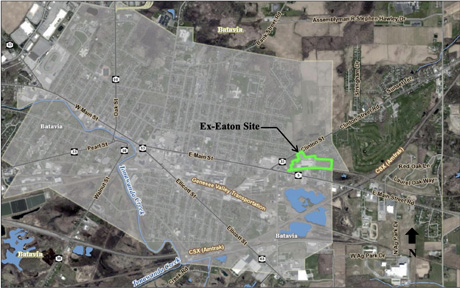
A city site known for the creation of collectible woven baskets, novelties and other manufacturing purposes will soon be a scene of environmental cleanup at the edge of Batavia.
Basket Place LLC, at 22 Clinton St., is 22.9 acres and is bordered to the north by Clinton Street (Route 33), to the south by the Erie Railroad, and to the east and west by residences. Properties south of the Erie Railroad are commercial/light industrial in nature, with some residences intermixed, according to a state Department of Environmental Conservation Fact Sheet.
The site was used to manufacture agricultural and highway equipment from the mid-1920s until the early 1990s. The current owner operates a warehousing facility for baskets and novelty items. Beginning in the late 1980s and continuing into the mid-1990s, the United States Environmental Protection Agency (USEPA) and the NYSDEC evaluated the site.
In the late 1990s, the previous site owner, O&K Orenstein & Koppel, Inc., conducted additional investigations after the site was sold to Basket Place, LLC. The on-site and off-site remedial investigations began in 2003 when CNH Industrial Baumaschinen GmbH entered into a Voluntary Cleanup Agreement (VCA). However, the Voluntary Cleanup Program was terminated by the NYSDEC in 2018.
The cleanup activities will be performed by CNH Industrial Baumaschinen GmbH with oversight provided by the state DEC, which has determined that the Remedial Action Work Plan submitted by GHD Consulting Services, Inc. on behalf of CNH, protects public health and the environment and has approved the plan.
Remedial activities are expected to begin in May 2023 and last about five months.
The goal of the cleanup action for the site is to achieve cleanup levels that protect public health and the environment. The key components of the remedy are:
- Excavation and off-site disposal of contaminated surface soil across the Site.
- Treating contaminated soil and groundwater through soil mixing with injection of In-Situ (i.e., in place) Chemical Reduction.
- Bioremediation injection into the groundwater as a barrier to treat and prevent further off-site migration of groundwater contamination.
- Collecting and analyzing post-remedial soil and groundwater samples to evaluate the effectiveness of the remedy.
- Importing or reuse of clean material that meets the established Soil Cleanup Objectives for use as a cover system. Placement of a cover system, including a demarcation layer over areas of spot excavations to address contamination remaining above commercial use soil cleanup objectives.
- Restoring the site cover where it is compromised, or placement of a 1-foot clean soil cover.
New York's Brownfield Cleanup Program (BCP) encourages the voluntary cleanup of contaminated properties known as "brownfields" so that they can be reused and redeveloped. The city of Batavia and Batavia Development Corporation have Brownfield programs for remediation and redevelopment of properties, such as the former Della Penna property on Ellicott Street, and the Creek Park property behind the ice arena.
These uses include recreation, housing, business or other purposes. A brownfield site is any real property where a contaminant is present at levels exceeding the soil cleanup objectives or other health-based or environmental standards, criteria or guidance adopted by DEC that are applicable based on the reasonably anticipated use of the property, in accordance with applicable regulations, the Fact Sheet states.
Action on the privately owned Basket Place parcel is to begin in May, and that will address contamination related to the otherwise known "Ex-Eaton Site" located at 22-40 Clinton St., Batavia. Refer to the green outline in the image above.
A site-specific health and safety plan and a Community Air Monitoring Plan will be implemented during remediation activities. These plans establish procedures to protect on-site workers and residents and include required air monitoring as well as dust and odor suppression measures.
Next Steps
After the applicant completes the cleanup activities, they will prepare a Final Engineering Report and submit it to NYSDEC. This report will describe the cleanup activities completed and certify that cleanup requirements have been achieved or will be achieved.
When state DEC is satisfied that cleanup requirements have been achieved or will be achieved for the site, it will approve the Final Engineering Report. DEC will then issue a Certificate of Completion to the applicant. The applicant would be able to redevelop the site in conjunction with receiving a Certificate of Completion. In addition, the applicant would be eligible for tax credits to offset the costs of performing cleanup activities and for the redevelopment of the site.
DEC will also issue a fact sheet that describes the content of the Final Engineering Report and identify any institutional controls (for example, environmental easements) or engineering controls (for example, a site cover) necessary at the site in relation to the issuance of the Certificate of Completion, the agency stated.
In 2019, remedial investigations continued at this site under the Brownfield Cleanup Program. Additional site details, including environmental and health assessment summaries, are available on NYSDEC's Environmental Site Remediation Database (by entering the site ID, C819022) HERE.
Meanwhile, cleanup efforts have been scheduled to resume this spring at the defunct Batavia Iron and Metal on Bank Street.
To learn more, go to the Brownfield Cleanup Program
Image of map from NYSDEC.
